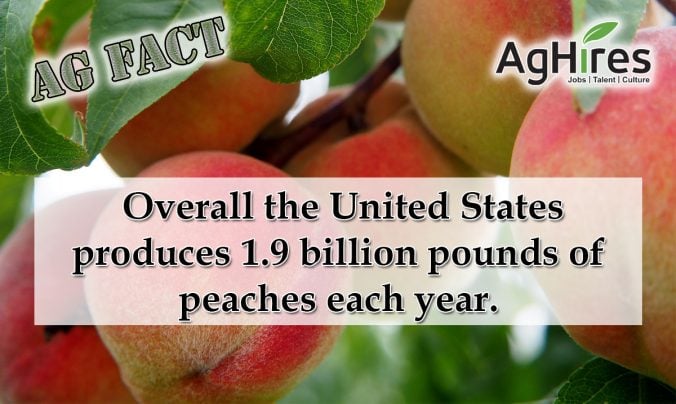
In 1982 President Ronald Regan declared August as National Peach Month, so we’re celebrating this month with fun facts about peaches. Not only is the entire month dedicated to peaches, but August 22nd is Eat a Peach Day and August 24th is National Peach Pie Day. So, whether you enjoy the fresh fruit or baking them into a dessert, this month is for you.
There are over 700 varieties of peaches in the world and they can all be divided into two groups, clingstone and freestone peaches. Clingstone peaches have the stones tightly attached the flesh, which are mostly used for canning. The freestone peaches have stones that can be easily removed and are primarily sold as fresh fruit.
Even though Georgia is known as the Peach State and produces 130 million pounds of the fuzzy fruit each year, California and South Carolina produce more annually. Overall the United States produces 1.9 billion pounds of peaches each year. Yes, that is billion, with a B. However, China produces 58% of the world’s peaches and nectarines each year.
The Peachy History
Peaches originated in China and were enjoyed by emperors. Recent data shows that domesticated peaches occurred as early as 6000 BC in Zhejiang Province of China. The fruit spread to Persia and where it was named the Persian Apple since many people believe the fruit originated there. Peaches spread to Europe thanks to Alexander the Great and by the 16th century Spanish explorers introduced the fruit to the Americas.
It wasn’t until the 17th century when the first tree was planted in Georgia. The peach industry didn’t start until after the Civil War when Georgia growers developed new superior varieties, which promoted the state the nickname “The Peach State.” The United States commercial peach industry accelerated quickly by the 1900s.
Producing Peaches
Most peach trees live about 15 years, but it takes two year for the tree to bear fruit. Even in the third year the tree isn’t as fruitful. By year 4 the tree is in it’s prime. When peaches become a creamy yellow color, they are picked by hand from the trees. Peaches don’t mature all at one time, so it is usually necessary to harvest a tree two, three, or even four times.
Once harvested, the fruit is immediately rinsed with cold water to stop the ripening process to ensure the fruit is not overripe when purchased by the consumer. They are then cleaned, while brushes remove the fuzz, and sent to be sorted. Finally, they are packed and shipped to stores or processing facilities, all within days of being harvested.
Other Facts:
- China is the only place you can find a true wild peach. The wild fruit is small, sour and very fuzzy.
- The flavor of a peach depends on the variety and not their color.
- North Carolina grows an average of 35 million pounds of fresh market peaches each year, ranking the state 9th in the United States.
- In 2014, the average American consumed 6.4 pounds of peaches each year.
- Flowers appear on the tree before the leaves and they are made up of 5 pink petals.
Want more Agriculture Facts? Click here
Follow us on Facebook and Twitter to get your weekly dose of Ag Facts.
Sources:
TonsOfFacts.com
FarmFlavor.com
Georgia Department of Agriculture
Agricultural Marketing Resource Center
DaysOfTheYear.com
Smithsonian Magazine





